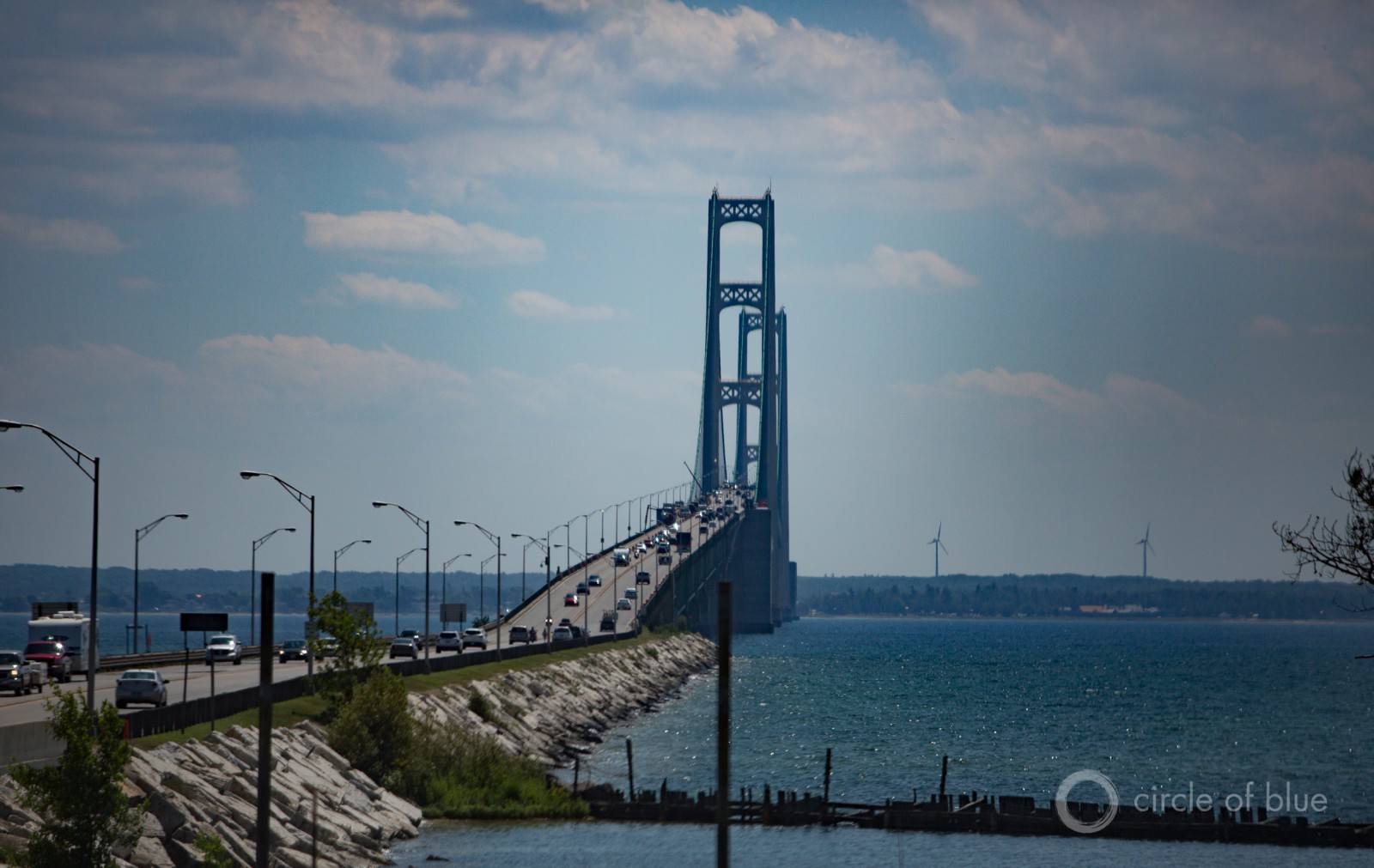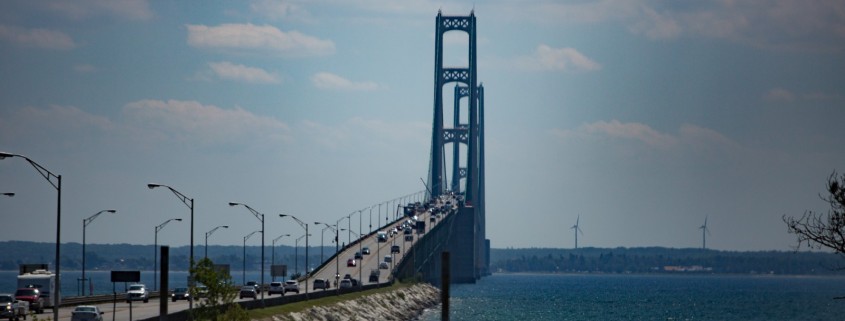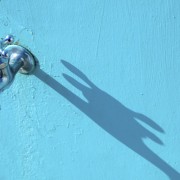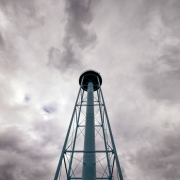Congress Strengthens Great Lakes Oil Pipeline Oversight
Pipeline safety bill includes three provisions directed at Line 5, an aging oil conduit across the Straits of Mackinac.

Enbridge, Inc.’s Line 5 pipeline splits in two and crosses beneath the waters of the Straits of Mackinac, near the site of Michigan’s Mackinac Bridge. Photo © J. Carl Ganter / Circle of Blue
By Brett Walton, Circle of Blue
Out of sight and out of mind until recently, two aging oil pipelines beneath the Straits of Mackinac, in northern Michigan, have soared from a regional concern to an authentic and nationally recognized risk to the Great Lakes ecosystem and economy. A new pipeline safety bill signed into law today by President Obama applies federal legal tools to a threat that steadily gained attention in the Great Lakes region over the last four years.
Though the PIPES Act does not mention the pipeline by name, the influence of Line 5, which spans the narrow channel between Lake Michigan and Lake Huron, is evident in the bill. Three provisions are directly targeted at the 63-year-old oil conduit, according to Carl Weimer, executive director of the Pipeline Safety Trust, a research group.
The action by Congress puts pressure on Michigan Gov. Rick Snyder. His administration is conducting two studies of the pipelines: one on the consequences of a Line 5 spill, the other on the risks to the state and regional economy if Line 5 were to be shut down. Last summer, a task force convened by Bill Schuette, the attorney general, concluded that assurances from Enbridge, the pipeline operator, that Line 5 is in “excellent condition” could not be verified with existing information. Schuette has said that “the pipeline’s days are numbered” and that the state should hasten their removal. The task force report also concluded that the state has the authority to seek a court order to shut down Line 5 if safety measures were not deemed adequate.
Bill Targets Line 5
One provision in the PIPES Act defines the Great Lakes as a “high consequences area” for an oil spill, a designation that triggers additional inspection and reporting requirements. A second measure orders pipeline operators to address in their spill response plans how to contain and clean up a leak beneath ice-covered water, which is a winter risk in the northern Great Lakes.
A third item requires annual inspections for pipelines that are not in marine waters and are more than 150 feet below the surface of the water. “Line 5 is the only pipeline that provision applies to, we think,” Weimer told Circle of Blue.
The provisions were written by Sen. Gary Peters, a Michigan Democrat who supports greater scrutiny of Line 5.
“The Great Lakes play a central role in our state’s economy, environment, and way of life,” said Sen. Peters in a statement. “We must ensure that the proper safety and oversight is in place to keep our people safe and our natural resources protected. I’m very pleased that this bill is on its way to the President’s desk to be signed into law and help safeguard against the catastrophic consequences of an oil spill in our precious waterways.”
Bill Requires More Planning and Inspection
Researchers at the University of Michigan have called the Straits of Mackinac the “worst possible place for an oil spill in the Great Lakes.” Swirling currents in the straits could spread oil across 1,000 kilometers (621 miles) of shoreline after a Line 5 spill, the researchers concluded in a March 2016 report.
Reflecting the steadily increasing public worry, the PIPES Act defines the Great Lakes as a “high consequence area.” The designation triggers a mandatory annual checkup of the pipeline’s internal condition. Exterior inspection for corrosion, dents, or weakness in the joints are to be completed as needed, though internal monitoring devices such as “smart pigs” can do both at once. Current law requires inspections once every five years. “The bill ratchets up the inspection frequency quite a bit,” Weimer said, noting that more frequent inspections are “a really good thing.”
The bill also expands planning requirements for all pipelines carrying hazardous liquids. Companies must document how they will corral and clean up a spill that fouls a waterway or shoreline, even if the spill occurs beneath ice. Ice complicates oil spill cleanup, the northern Great Lakes are often frozen in winter, and the U.S. Coast Guard claims that current oil response capacity in icy conditions is inadequate. The plans are submitted to the U.S. Department of Transportation’s Pipeline and Hazardous Materials Safety Administration.
Weimer assumed that pipeline operators were supposed to include these assessments already, but it is good that the bill “makes it crystal clear,” he said.
Peters and his Michigan colleague Sen. Debbie Stabenow are keeping close watch on the state’s oversight of the aging Line 5 and maintaining pressure on the Snyder administration.
On April 19, the senators wrote a letter to Gov. Snyder, Attorney General Bill Schuette and the heads of the departments of Environmental Quality and Natural Resources. The letter requested that the state complete with appropriate urgency and swiftness the studies of Line 5’s condition and determine whether the pipelines violate state-mandated design standards.
Brett writes about agriculture, energy, infrastructure, and the politics and economics of water in the United States. He also writes the Federal Water Tap, Circle of Blue’s weekly digest of U.S. government water news. He is the winner of two Society of Environmental Journalists reporting awards, one of the top honors in American environmental journalism: first place for explanatory reporting for a series on septic system pollution in the United States(2016) and third place for beat reporting in a small market (2014). He received the Sierra Club’s Distinguished Service Award in 2018. Brett lives in Seattle, where he hikes the mountains and bakes pies. Contact Brett Walton









